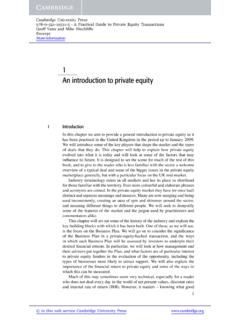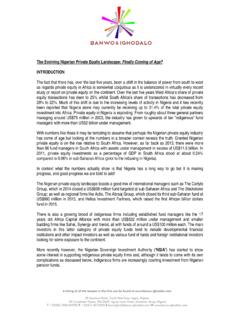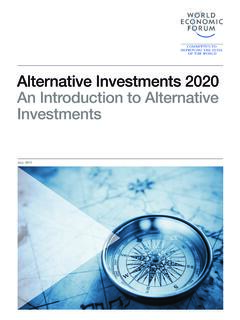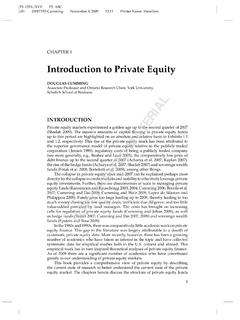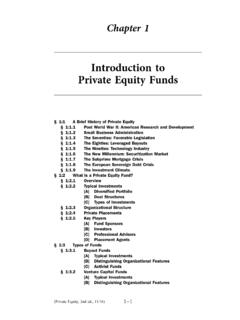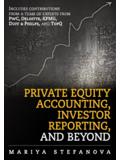Transcription of Private equity: a Brief Overview - Sturm College of Law
1 equity : a Brief OverviewAn introduction to the fundamentals of an expanding, global industryBy David Snow, Executive Editor, PEI MediaSection 1:IntroductionSection 3: Private equity fundsSection 4: Private equity fundraisingSection 5: Private equity dealsSection 6: Private equity performanceSection 7: Recent trends in Private equitySection 2: Private equity firmsPrivate equity : A Brief OverviewAn introduction to the fundamentals of an expanding, global industryBy David Snow, Executive Editor, PEI MediaSection 1 IntroductionPrivate equity , in a nutshell, is the investment of equity capital in Private companies. In a typical Private equity deal, an investor buys a stake in a Private company with the hope of ultimately realising an increase in the value of that stake.
2 There is today an increas-ingly massive and variegated industry devoted to pursuing wealth creation in roughly this Private equity industry, once a rather obscure collec-tion of specialist investment firms, is now a major force in the world. It annually attracts and deploys hundreds of bil-lions of dollars. Some (but not all) people and institutions that have allowed Private equity firms to invest their money have enjoyed stellar returns. This record of success (or perceived record of success) has led to Private equity enjoying a high degree of interest from investors, corporate executives, young professionals, regulators, politicians, the press and the general public.
3 This primer, Private equity : A Brief Overview , is designed to give a quick tour through the basic structures and func-tions of Private equity firms, funds and deals, as well as to note some important trends in today s rapidly expanding and transforming Private equity market. I have bolded key termi-nology for easy Media, through its flagship magazine Private equity International and other publications, has been covering the global Private equity market since 2001. I have been writing about Private equity since the late 1990s. During these years I have on many occasions delivered my Private equity in a nutshell explanation to new reporters, members of the main-stream media and curious friends.
4 This primer is a slightly more elaborate version of these chats, but only slightly. For the sake of brevity, I deliberately have left out detailed in-formation touching on Private equity data, performance, tax, financial and legal issues. For these, you should con-sult the many educational materials available through , among oth-er resources. Before we begin, a couple of quick notes:Although some media and industry participants use the term in different ways, the term Private equity is used here to cover all forms of investment in Private companies, from early stage venture capital to growth equity to leveraged buyouts to turnaround investments of fi-nancially troubled companies.
5 A Private equity firm, in its most conventional form, is not the only type of institution engaged in Private equity investing. But it is the entity that will take centre stage for the purposes of this discussion, as most of the Private equity investment in the world now is conducted by Private equity firms deploying capital out of dedicated funds that are typically structured as blind-pool limited partnerships (more on this later). 3: Private equity fundsSection 4: Private equity fundraisingSection 5: Private equity dealsSection 6: Private equity performanceSection 7: Recent trends in Private equityNo part of this documeNt may be reproduced without prior writteN permissioN from pei media Private equity : a Brief Overview 2 Section 2: Private equity firmsPrivate equity , in a nutshell, is the investment of equity capital in Private companies.
6 Section 1:IntroductionSection 2 Private equity firmsThe practice of multiple parties conducting business through a partnership is an ancient one. Among the earliest commercial partnerships were ones formed to raise money for seafaring ventures. The investors who stayed back home deemed it ap-propriate for the people who actually captained the ships to receive a disproportionate share of the spoils. In today s pri-vate equity trade, the Private equity firms can be thought of as the ships, and the general partners as the captains who get a disproportionate share of profits (if there are any). Private equity firms are groups of individuals who come together to pursue Private equity investments.
7 While almost all Private equity professionals invest a portion of their own money, Private equity firms today primarily deploy capital on behalf of others. These firms tend to be partnerships, similar in form to other Private professional services firms, like law firms, for example. A Private equity firm today might range in size from two people and a secretary to hundreds of invest-ment professionals. The business model of a Private equity firm is as follows raise capital from external sources, invest the capital in a se-ries of Private equity deals, sell (or exit ) those investments (often many years later), and return the proceeds from these exits to the external capital partners while holding back 20 percent of the total profits for the partners of the Private equity firm.
8 This 20 percent take is called carried interest. Carried interest is the gravitational pull at the center of the Private equity universe. The general partners also earn sub-stantial income from other fees, such as management fees and transaction fees. Private equity firms usually raise capital for investments into a fund, usually in the form of a limited partnership, which is a kind of fund that gives control and a disproportionate share of the profits to the general partners, even though most of the capital in the fund tends to come from external investors. As limited partners, these investors have little control over how the fund is managed and agree in advance to the lopsided prof-it-sharing agreement, as well as to the other fees.
9 When successful, a Private equity firm can create a fortune for its founders. Here s a very simplistic example - let s say a group of five general partners (often referred to as GPs) raises a $500 million fund and invests it in a series of deals. When those investments are finally all sold off, the resulting value is twice that of the fund - $1 billion. This means the fund has a profit of $500 million. As part of the profit sharing agreement, the general partners keep 20 percent of this $500 million profit, equal to $100 million. Assuming they all share equally in this windfall, each general partner keeps $20 million. Nice work, if you can get it.
10 This example doesn t even factor in the other potentially lucrative management and transaction fee streams available to the general partners (to be discussed later). The fortune-building possibilities of a Private equity firm have led to the establishment of thousands of such firms around the world. As recently as the 1970s, it was hard to count more than a few dozen Private equity firms, primarily venture capi-tal and leveraged buyout groups located in the United States. Now there are Private equity firms both miniscule and enor-mous in all the developed countries of the world and in most of the emerging markets. A testament to the flexibility of the traditional Private equity firm structure, these firms pursue a vast array of strategies.










